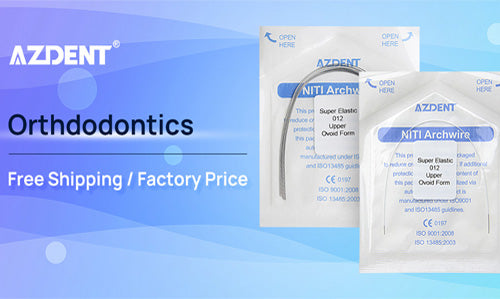In the last article, we learned about the classification of dental arch wires and our company’s popular dental super elastic niti arch wire. Today, we will introduce the commonly used dental arch wires.
Dental heat activated NiTi arch wire
As a shape memory alloy, the dental thermally activated NiTi arch wire undergoes plastic deformation at low temperature and is fixed into another shape. When it is heated above a certain critical temperature, it can be recovered to original shape again. In the current clinical treatment process, due to the shape memory function and good biocompatibility of thermally activated dental arch wire, it is widely welcomed by orthodontists and is widely used in clinical practice.
Features:
1. The thermally activated dental arch wire has complete arch shape, good flexibility, special surface with electrochemical polishing, and high fatigue resistance. During the treatment process, the dental arch wire is not easily broken, and it has moderate hardness.
2. The temperature for complete recovery of elasticity is set at 32 degrees Celsius, which is easy to bend at low temperature, easy to ligate, and can provide long-term light force to promote tooth movement.
3. The dental heat-activated round arch wire is less painful for patients to align the teeth in the early stage of orthodontic treatment, and the dental heat-activated rectangular arch wire has obvious effect in the early torque control.
Dental stainless steel arch wire
Dental stainless steel arch wire is a stable orthodontic material, not only has the advantages of good biocompatibility, stable chemical properties, convenient processing and molding, good welding performance, rich material sources, etc., but also can ensure the structure and shape of the orthodontic arch wire is stable.
The advantages of the stainless steel dental arch wire are good bending performance, corrosion resistance and low price. The dental stainless steel arch wire has a large elastic modulus, and its size is affected by many factors, such as alloy composition, drawing process, heat treatment and so on.
Dental reverse curve NITI arch wire
The dental reverse curve NITI arch wire conforms to the standard shape of most people’s jaws. The cross section of the dental arch wire is round or rectangular, and the material of the dental arch wire is medical nickel-titanium shape memory alloy. The use of dental reverse curve arch wire to correct deep overbite can reduce the discomfort of patients during the process of orthodontic treatment, and avoid oral soft tissue ulcers and difficulty in oral cleaning. At the same time, it can also greatly reduce the difficulty and complexity of orthodontic treatment, make it easier for clinicians to adjust and operate, and greatly save the clinician's chair-side operation time.
Invisible dental arch wire
The layer material of invisible dental arch wire is resin. The coating is non-toxic, has no stimulating effect on oral mucosa, and has a hemolysis rate of 2%. Various colors are available. The dental arch wire is beautiful and firm, brings less pain to the patient, and convenient to operate.
Orthodontic Cu-NiTi arch wire
In terms of material science, the nitinol wire is unique in its super-elastic property and metal memory ability, which can keep its strength soft and durable during the treatment process. The main composition is 50%-55% nickel and copper, chrome. It has good comprehensive performance and can resist various acid corrosion and stress corrosion. The copper-nickel-titanium alloy is the addition of 59%-65% copper and 0.2%-0.5% chromium to the nickel-titanium alloy, thereby changing the phase transition temperature and super-elastic properties of the alloy.
In addition to the introduction in the article, our company also sells various types of dental arch wires; please contact us if you have any needs!


